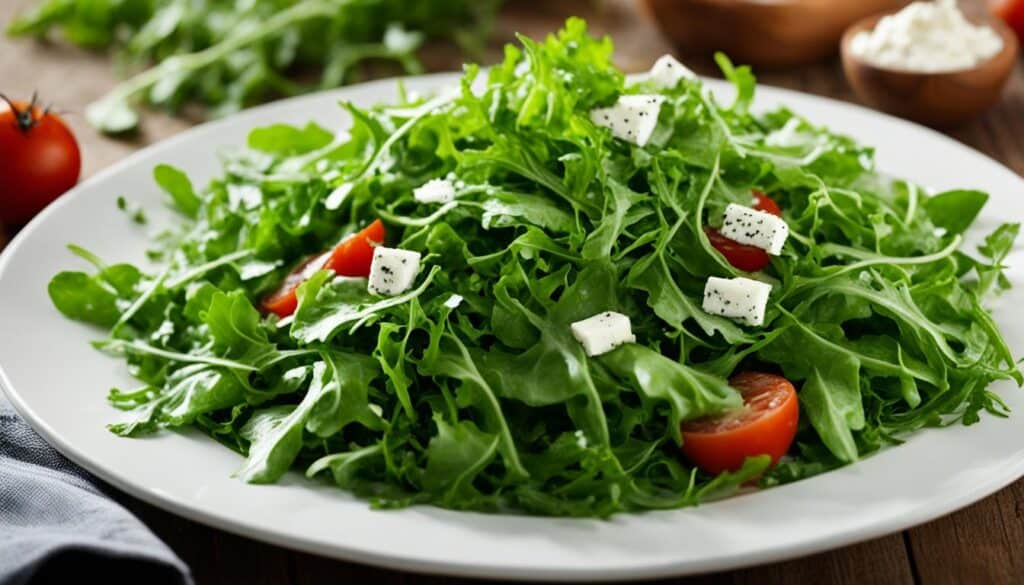Did you know that arugula lettuce, also known as rucola or salad rocket, offers a range of health benefits that can have a significant impact on your well-being? This often overlooked leafy green is packed with essential nutrients and has been linked to various positive effects on the body. From cancer-fighting properties to support for bone health and heart health, arugula lettuce is a powerhouse of nutrition that deserves a place on your plate.
Arugula lettuce belongs to the cruciferous vegetable family, alongside well-known superfoods like broccoli and kale. Despite its low calorie and carbohydrate content, arugula is loaded with fiber, calcium, potassium, folate, vitamin C, vitamin K, and vitamin A. But it doesn’t stop there—studies have also suggested that arugula may have cancer-fighting properties and can support bone health, heart health, and diabetes management.
With its distinct peppery flavor, arugula lettuce can elevate the taste of various dishes. Add it to salads, sandwiches, wraps, or pasta for a burst of freshness and nutritional goodness. The possibilities are endless!
Key Takeaways:
- Arugula lettuce is a nutrient-dense leafy green that offers a range of health benefits.
- It is high in fiber, calcium, potassium, folate, vitamin C, vitamin K, and vitamin A.
- Studies suggest that arugula may have cancer-fighting properties.
- Arugula supports bone health, heart health, and diabetes management.
- This versatile green can be used in a variety of dishes, from salads to pasta.
Nutrient Content of Arugula Lettuce
Arugula lettuce is a nutritional powerhouse, packed with essential nutrients that contribute to overall health. Let’s explore the rich nutrient content of arugula lettuce:
Calcium: Essential for Bone Health
Arugula is a rich source of calcium, a mineral vital for maintaining strong bones, as well as supporting muscle function and nerve function.
Potassium: Supporting Heart and Nerve Function
High in potassium, arugula helps promote optimal heart and nerve function, while also aiding in regulating blood pressure levels.
Folate: Supporting DNA Production and Neural Tube Development
Arugula lettuce is a good source of folate, a B vitamin with crucial roles in DNA production and neural tube development, particularly important for pregnant women.
Vitamin C: Strengthening the Immune System
Rich in vitamin C, arugula provides a powerful antioxidant boost, strengthening the immune system and aiding in the absorption of iron.
Vitamin K: Assisting in Blood Coagulation
Arugula contains vitamin K, which plays a vital role in blood coagulation, ensuring proper clotting when necessary.
Vitamin A: Supporting Vision, Immune Function, and Organ Health
Arugula lettuce is also a source of vitamin A, essential for vision, immune function, and overall organ health.
As you can see, arugula lettuce is not only a flavorful green but also a nutrient-rich addition to your diet. Incorporating arugula into your meals is a delicious way to boost your nutrient intake and support your overall health.
Cancer-Fighting Properties of Arugula Lettuce
Arugula lettuce, in addition to its delicious taste, offers numerous health benefits, including cancer-fighting properties. This cruciferous vegetable contains glucosinolates, sulfur-containing compounds responsible for its distinct bitter taste. When broken down by the body, these compounds release beneficial compounds like sulforaphane. Studies have shown that sulforaphane can inhibit the progression of cancer cells by blocking specific enzymes.
Diets rich in cruciferous vegetables, such as arugula lettuce, have been associated with a decreased risk of several cancers, including breast, prostate, lung, and colon cancer. However, further research is necessary to fully comprehend the extent of arugula’s cancer-fighting potential.
To include arugula lettuce in your daily diet, try incorporating it into salads, sandwiches, wraps, or pasta dishes. The versatility of this leafy green allows for creative and delicious meal options that provide both taste and health benefits.
| Cancer Type | Prevention | Treatment |
|---|---|---|
| Breast Cancer | Studies have shown that arugula lettuce, along with other cruciferous vegetables, may help reduce the risk of breast cancer. | The potential for arugula as a standalone treatment for breast cancer is still being investigated. It should not replace conventional treatment methods. |
| Prostate Cancer | Arugula lettuce contains beneficial compounds that have demonstrated an ability to inhibit the growth of prostate cancer cells. | While arugula may have potential as a natural complementary treatment method, it should not be relied upon as the sole form of treatment for prostate cancer. |
| Lung Cancer | Consuming arugula lettuce as part of a healthy diet that includes a variety of fruits and vegetables has been associated with a reduced risk of lung cancer. | Arugula lettuce cannot cure lung cancer, but it may assist in maintaining overall health during and after treatment. |
| Colon Cancer | Arugula lettuce, due to its high fiber content, may help prevent colon cancer by promoting regular bowel movements and reducing the risk of constipation. | It is important to consult with a healthcare professional about appropriate treatment methods for colon cancer. Arugula lettuce alone is not a substitute for medical advice. |
Arugula Lettuce and Bone Health
Arugula lettuce is a fantastic addition to your diet if you want to promote strong and healthy bones. Rich in calcium and vitamin K, arugula provides essential nutrients that are vital for maintaining bone strength, density, and overall bone health.
Calcium is a key mineral responsible for the proper development and maintenance of bones. It helps to build and strengthen bone tissue, preventing bone loss and reducing the risk of osteoporosis and fractures.
On the other hand, vitamin K plays a crucial role in bone metabolism and mineralization. It aids in the production of osteocalcin, a protein necessary for proper bone density and strength.
| Nutrient | Amount in 1 cup of Arugula | % Daily Value* |
|---|---|---|
| Calcium | 32 mg | 3% |
| Vitamin K | 21.1 mcg | 18% |
*Daily values based on a 2,000 calorie diet
By incorporating arugula into your meals, you can enhance your calcium and vitamin K intake, ultimately supporting your bone health. Whether you enjoy it in salads, sandwiches, or as a topping for pizzas, arugula is a versatile and delicious way to fortify your bones.
Arugula Lettuce and Diabetes Management
The Benefits of Arugula Lettuce for Diabetes
When it comes to managing type 2 diabetes, incorporating arugula lettuce into your diet might offer some valuable benefits. This leafy green, along with other leafy vegetables, is packed with fiber, which plays a crucial role in regulating blood glucose levels and reducing insulin resistance. But arugula lettuce provides even more advantages for diabetes management.
One of the key compounds found in arugula lettuce is glucosinolates, which gives it the characteristic bitterness and also potentially acts as an antidiabetic agent. Research has shown that arugula extract stimulates glucose uptake in cells, improving glucose metabolism and helping to maintain healthy blood sugar levels.
Additionally, a high-fiber diet that includes arugula lettuce can promote satiety, reducing the risk of overeating and aiding in weight management. Maintaining a healthy weight is an important aspect of diabetes management, as it can contribute to better blood sugar control and overall well-being.
Arugula Lettuce Recipe for Diabetic-Friendly Meals
Incorporating arugula lettuce into your meals can be a delicious and nutritious way to support diabetes management. Here’s a simple recipe idea to get you started:
| Arugula Salad with Grilled Chicken and Balsamic Dressing |
|---|
|
Incorporating Arugula Lettuce into Your Diabetic Meal Plan
There are various ways to incorporate arugula lettuce into your diabetic meal plan. You can add it to salads, sandwiches, wraps, or pasta dishes for a burst of flavor and nutritional benefits. Arugula can also be blended into fresh juices or smoothies for an added nutrient boost. Don’t be afraid to get creative and experiment with different combinations and recipes!
Remember, it’s essential to work with your healthcare provider or a registered dietitian to develop a personalized meal plan that suits your specific dietary needs and diabetes management goals.
“Incorporating arugula lettuce into meals is a delicious and nutritious way to support diabetes management.”
By including arugula lettuce in your diet, you can take a step towards better diabetes management and enjoy the many health benefits this leafy green has to offer.
Arugula Lettuce and Heart Health
Consuming arugula lettuce and other cruciferous vegetables can have a favorable impact on heart health. These vegetables are abundant in polyphenols and organosulfur compounds, known for their potential to reduce the risk of cardiovascular disease. Diets rich in cruciferous vegetables, including arugula, salads, and green leafy vegetables, have been associated with a decreased likelihood of atherosclerosis, a condition characterized by arterial plaque buildup. Arugula’s nutrient profile, which includes significant levels of antioxidants, fiber, and phytochemicals, contributes to its heart-protective properties.
Arugula lettuce and other cruciferous vegetables are packed with heart-healthy nutrients. Here is a breakdown of some key nutrients:
| Nutrient | Function | Food Sources |
|---|---|---|
| Polyphenols | Support heart health by reducing inflammation and oxidative stress. | Arugula, broccoli, kale |
| Organosulfur compounds | Help lower blood pressure and regulate cholesterol levels. | Arugula, cabbage, Brussels sprouts |
| Antioxidants | Protect against cardiovascular damage caused by free radicals. | Arugula, spinach, Swiss chard |
| Fiber | Aids in maintaining healthy cholesterol levels and reducing the risk of heart disease. | Arugula, lettuce, collard greens |
| Phytochemicals | Support heart health by reducing inflammation and improving blood vessel function. | Arugula, watercress, mustard greens |
Eating arugula lettuce as part of a balanced diet can contribute to overall cardiovascular wellness. Its combination of essential nutrients, including polyphenols, organosulfur compounds, antioxidants, fiber, and phytochemicals, work together to support heart health and reduce the risk of heart disease. Including arugula in meals and enjoying its distinct flavor can be an enjoyable way to prioritize your cardiovascular well-being.
Incorporating Arugula Lettuce into Your Diet
Arugula lettuce is not only nutritious but also versatile, making it easy to incorporate into your daily meals. Here are some innovative ways to enjoy arugula lettuce:
1. Refreshing Salads
Arugula lettuce adds a peppery and tangy flavor to salads, making them more vibrant and refreshing. Combine arugula with other greens like spinach or mixed lettuce for a nutritious and colorful salad. Add a burst of sweetness with citrus fruits like oranges or grapefruits, and enhance the flavors with juicy berries like strawberries or raspberries.
2. Toppings for Savory Dishes
Use arugula as a flavorful topping for savory dishes. Sprinkle it over homemade pizzas as a fresh and crunchy addition. Add it to baked potatoes along with sour cream and chives for a nutritious twist. Arugula can also be tossed into pasta dishes, soups, and sauces to elevate their taste and provide a healthy boost.
3. Substitute for Lettuce in Sandwiches
Swap out traditional lettuce with arugula in your sandwiches for a more robust and flavorful experience. Arugula pairs perfectly with savory ingredients like grilled chicken, turkey, or smoked salmon. Its peppery kick complements the other flavors and adds a unique twist to your favorite sandwich.
4. Nutrient-Boosting Juices and Smoothies
Blend arugula into your fresh juices or smoothies to add a nutritional boost. Its tenderness makes it quick to blend, and it pairs well with fruits like pineapple, apple, or mango. The combination of arugula and fruits creates a vibrant and refreshing beverage that provides essential vitamins and minerals.
5. Sautéing with Other Greens
For a simple yet delicious side dish, sauté arugula with other milder greens like spinach or Swiss chard. The combination of flavors creates a balanced and nutritious addition to any meal. Sautéing arugula lightly preserves its flavor and texture while unlocking its health benefits.
6. Homegrown Arugula
Arugula is also easy to grow at home, allowing you to have a continuous supply of fresh greens. Whether you have a garden or limited space, arugula can be grown in containers or even on a sunny windowsill. Enjoy the satisfaction of cultivating your greens and creating delicious meals straight from your garden.
Remember to wash arugula thoroughly before use and store it in the refrigerator to maintain its freshness for longer.
Arugula lettuce is a versatile ingredient that adds flavor and nutrition to a wide range of dishes. Whether you incorporate it into salads, use it as a topping, substitute it for lettuce, blend it into juices or smoothies, sauté it with other greens, or grow it at home, arugula lettuce can elevate your culinary creations and contribute to a healthy diet.
Buying and Growing Arugula Lettuce
When it comes to enjoying the delightful taste and numerous health benefits of arugula lettuce, you have a couple of options. You can either buy it from your local grocery store, farmers’ market, or explore online sources. Regardless of where you choose to purchase arugula, keep an eye out for fresh and vibrant leaves. Select bunches that are free from wilting or browning to ensure optimal flavor and quality.
If you decide to buy arugula, it’s essential to store it properly to maintain its freshness and nutritional value. Refrigerate arugula in a sealed bag or container and consume it within a few days. This storage method helps preserve the vibrant green color and crisp texture that make arugula so appealing.
For those who are interested in cultivating their own fresh greens, growing arugula at home is an accessible and rewarding project. In fact, arugula is one of the easiest vegetables to grow, making it suitable for beginners and seasoned gardeners alike.
To successfully grow arugula, you have two primary options: using containers or planting it directly in the ground. Ensure that the soil is well-drained and rich in organic matter to promote healthy growth. Arugula prefers moderate sunlight and regular watering to keep the soil moist but not waterlogged.
“Growing arugula at home allows you to enjoy the satisfaction of harvesting your own fresh greens and adding them to your meals. The process is relatively fast, and you can start harvesting young leaves as soon as they reach a desirable size.”
Whether you choose to buy or grow arugula, you’ll be able to experience the joy of incorporating this versatile leafy green into your culinary creations. From adding a peppery kick to refreshing salads to using it as a flavorful topping for pizza or pasta, arugula offers endless possibilities to elevate the taste and nutritional value of your dishes.
If you’re interested in further exploring the benefits of arugula lettuce and discovering delicious recipe ideas, continue reading to the next section.
Delicious Arugula Salad Ideas
Arugula salads can be both nutritious and delicious. Here are a few ideas to inspire your creativity:
1. Arugula Strawberry Salad: Combine fresh arugula, juicy sliced strawberries, creamy goat cheese, and crunchy almonds. Drizzle with a tangy balsamic vinaigrette for a refreshing and flavorful salad.
2. Mediterranean Arugula Salad: Toss arugula with chopped cucumbers, cherry tomatoes, Kalamata olives, feta cheese, and a sprinkle of dried oregano. Dress with lemon juice and olive oil for a taste of the Mediterranean.
3. Arugula Pear Salad: Mix arugula with sliced ripe pears, crumbled blue cheese, and candied walnuts. Drizzle with a honey mustard dressing for a sweet and savory combination.
4. Caprese Arugula Salad: Arrange arugula leaves, cherry tomatoes, fresh mozzarella cheese, and torn basil leaves on a plate. Drizzle with balsamic glaze and extra-virgin olive oil for a classic Italian salad.
5. Arugula Avocado Salad: Combine arugula with sliced avocado, diced cucumbers, cherry tomatoes, and crumbled feta cheese. Toss with a lemon garlic dressing for a creamy and tangy salad.
Tip: Feel free to add grilled chicken, shrimp, or salmon to any of these salads for added protein and a more substantial meal.
Arugula salads are versatile, allowing you to experiment with different combinations of ingredients and dressings. Don’t be afraid to get creative and make your own signature arugula salad!
Fresh Arugula in Hot and Cold Recipes
Fresh arugula can elevate the flavor profile of both hot and cold recipes, offering a delightful peppery taste and a range of nutritional benefits. Consider incorporating fresh arugula into the following dishes:
-
Arugula salad with roasted beets and goat cheese
-
Grilled chicken and arugula wrap with a tangy lemon dressing
-
Arugula and cherry tomato pizza with a balsamic glaze
-
Arugula pasta salad with sun-dried tomatoes, olives, and feta cheese
-
Arugula and watermelon salad with a refreshing mint vinaigrette
-
Seared steak with warm arugula and Parmesan salad
-
Arugula pesto pasta infused with garlic and pine nuts
These are just a few ideas to inspire your culinary creativity with fresh arugula. Experiment with different flavor combinations and textures to create unique and delicious dishes that feature this vibrant leafy green.
Adding fresh arugula to your recipes not only enhances the taste but also provides a nutrient boost. Its rich content of vitamins, minerals, and antioxidants can contribute to a healthier diet and lifestyle.
Conclusion
Arugula lettuce, also known as rucola, salad rocket, and Italian cress, is a powerhouse of nutrition and flavor. Its impressive health benefits make it a valuable addition to any diet. Packed with essential vitamins, minerals, and antioxidants, arugula supports overall well-being.
One of the standout features of arugula is its cancer-fighting properties. Studies have shown that the compounds found in arugula, such as glucosinolates, can inhibit the progression of cancer cells. This leafy green also contributes to bone health, thanks to its high calcium and vitamin K content. Regular consumption of arugula can help prevent the risk of osteoporosis and bone fractures.
Arugula lettuce has also been linked to diabetes management and heart health. Its fiber content aids in regulating blood glucose levels and reducing insulin resistance, making it beneficial for individuals with type 2 diabetes. And with its high levels of antioxidants, fiber, and phytochemicals, arugula supports a healthy heart and helps reduce the risk of cardiovascular disease.
Whether you add arugula to your salads, sandwiches, pasta, or wraps, or use it as a pizza or baked potato topping, this versatile leafy green can elevate your culinary creations. It can be easily incorporated into your diet, whether you buy it from stores or grow it at home. So why not start enjoying the health benefits and flavor of arugula lettuce today?










Leave a Reply